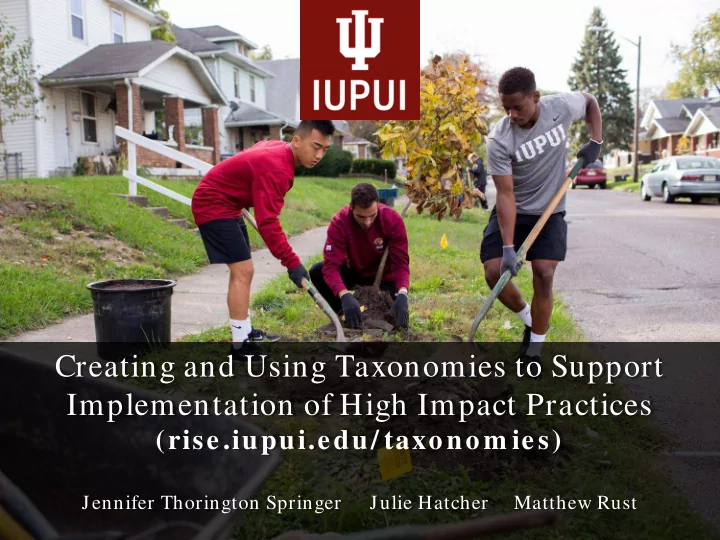

Creating and Using Taxonomies to Support Implementation of High Impact Practices (rise.iupui.edu/ taxonom ies) Jennifer Thorington Springer Julie Hatcher Matthew Rust
Enrollm ent Research Com m unity Engagem ent • 30K students • $428.9 million in • >800 Community (20K Undergrad) external funding in Partners (‘15-’16) 2015–2016 • 80% of Undergrads • > 10K students attend full-time 100 research participate annually • Centers • 87% are in-state • >1.1 million hours of • TRIP and publicly- course-based service • 18 Schools engaged contributed annually scholarship
Discussion Session Overview
Framing the Discussion Questions 1. Assume you are in a fa culty d ev elop m en t role (e.g., a CTL, dept chair), how could you use a taxonomy for faculty and course development? 2. Assume you are an instructor using the taxonomy, how could you use it to support your ow n a ssessm ent/ resea rch/ SoTL? 3. Assume you are responsible for course or p rogra m a ssessm ent/ im p rov em ent, how could you use the taxonomy to support institutional assessment goals?
RISE (HIPs) at IUPUI
RISE Mission To provide all students with broad access to quality education through inclusive and equitable high-im pact practices that result in transform ative student learning in support of tim ely graduation and prepare students to become actively engaged and inform ed citizens ready to participate in a global society.
R esearch I nternational S ervice-Learning E xperiential
RISE Goals For Students Challenges Students to Participate in at Least Two • High Impact Practices Engages Students More Deeply in Their Learning • Promotes Application of Knowledge through • guided reflection Helps Students Further Clarify and Commit to • Their Career Goals Allows students opportunities to reflect on • personal growth and development
HIP Participation Rates First Years Seniors IUPUI students significantly more likely to participate in learning • communities, service learning, internships or field experience, and capstones. IUPUI students less likely to participate in study abroad. • Similar levels of participation in undergraduate research. •
HIP Participation Rates 100.0% 90.0% 80.0% 70.0% 60.0% 50.0% 40.0% 30.0% 20.0% 10.0% 0.0% 1st Years with 1st Years with Seniors with Seniors with 1+ HIP 2+ HIPs 1+ HIP 2+ HIPs White Black/Af. Am. Hisp./Latinx
Taxonomies Background • Exec. Vice Chancellor • Cal State University • AAC&U • IUPUI • rise.iupui.edu/ taxonomies
HIPs Done Well Expectations • Time/ effort • Faculty + Peer Interaction • Diversity • Feedback • Reflection • Relevance • Public Demonstration •
Intended Benefits of Taxonomy Approach • Qua lity Course/ Progra m Dev elop m ent • Fid elity • Assessm ent • Resource
Challenges • Instructor Suspicion • Incentives • Taxonomy vs. Rubric • Low, Medium, and High Descriptors • Process for Input • What next?
Service Learning Taxonomy • Development • Unique Features/ Challenges • Implementation • FLC use and feedback
Reciprocal Partnerships Diversity of Interactions and Dialogue Civic Com petencies Critical Reflection Com m unity Project Assessm ent Service Learning Course Attributes
Institutional Reciprocal Cam pus Type & Partnerships Mission Location & Culture Diversity of Interactions and Dialogue Civic Com petencies Critical Reflection Duration of Com m unity Project Teaching Philos. Com m unity Epist. Project Assessm ent Prior Learning Experiences of Student Service Learning Course Attributes
Internship Taxonomy • Development • Unique Features/ Challenges • Implementation
High Im pact Higher Im pact Highest Im pact 1) Student performs 1) Student performs 1) Student performs no som e menial tasks at very few menial tasks menial tasks at internship site but at internship site; internship site; majority of work is majority of students’ students’ work is directly applying work is directly directly applying classroom learning, applying classroom classroom learning, under the close learning, under the under the supervision supervision of a supervision of a of a professional, but professional. professional. with a few opportunities for discretionary decision-m aking.
Themed Learning Communities Taxonomy • Development • Unique Features/ Challenges • Implementation
TLC Advisory Board Process • What are the hallmarks of a TLC? • Discussion/ Debate
Processes
THEMED LEARNING COMMUNITIES 5 Attributes • Interdisciplinary theme • Integration • Out-of-class activities • Active learning • Collaboration
Q+A Session
Discussion Question 1. Fa culty d ev elop m en t role (e.g., a CTL, dept chair), how could you use the taxonomy for faculty and course development? 2. I nstructor role, how could you use the taxonomy to support your ow n a ssessm ent/ resea rch/ SoTL? 3. Pogra m a ssessm ent/ im p rov em ent role, how could you use the taxonomy to support institutional assessment goals?
New Institute for Engaged Learning • To provide greater access and opportunity for students to engage in evidence-based high-im pact practices designed to foster their academic achievement, identity development, retention, and persistence to timely degree completion. • Leverage existing resources —human, fiscal, physical, and intellectual—across campus that contribute to engaged learning in order to generate greater efficiencies through better coordination and integration of student-facing programs and services.
New Institute for Engaged Learning Supports and develops m eaningful curricular pathw ays that are integrative, applied, and experiential. Intensive planning this academic year • HIPS - curricular and co-curricular • Community engagement • Assessment, SoTL, research on best practice • National search for Exec. Associate Dean this • spring/ summer ~ We w elcom e and value your ideas ~
Jennifer Julie Matthew Thorington Springer Hatcher Rust Director, Executive Director, Director, RISE Program Center for Service and Cam pus Career and Learning Advising Services jtspring@iupui.edu jhatcher@iupui.edu mmrust@iupui.edu rise.iupui.edu/ taxonom ies
Recommend
More recommend